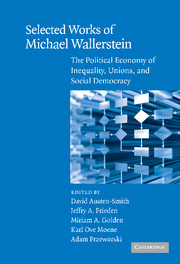 Selected Works of Michael Wallerstein
Selected Works of Michael Wallerstein Book contents
- Frontmatter
- Contents
- Preface and Acknowledgments
- 1 GENERAL INTRODUCTION
- Part I Class Conflict, the State, and Economic Limits to Democracy
- Part II The Politics of Labor Organizations
- 6 INTRODUCTION
- 7 UNION ORGANIZATION IN ADVANCED INDUSTRIAL DEMOCRACIES
- 8 CENTRALIZED BARGAINING AND WAGE RESTRAINT
- 9 POSTWAR TRADE-UNION ORGANIZATION AND INDUSTRIAL RELATIONS IN TWELVE COUNTRIES
- 10 UNIONS IN DECLINE? WHAT HAS CHANGED AND WHY
- Part III Inequality and Redistribution
- Part IV Labor and the Nordic Model of Social Democracy
- Other Books in the Series
- References
8 - CENTRALIZED BARGAINING AND WAGE RESTRAINT
Published online by Cambridge University Press: 27 January 2010
- Frontmatter
- Contents
- Preface and Acknowledgments
- 1 GENERAL INTRODUCTION
- Part I Class Conflict, the State, and Economic Limits to Democracy
- Part II The Politics of Labor Organizations
- 6 INTRODUCTION
- 7 UNION ORGANIZATION IN ADVANCED INDUSTRIAL DEMOCRACIES
- 8 CENTRALIZED BARGAINING AND WAGE RESTRAINT
- 9 POSTWAR TRADE-UNION ORGANIZATION AND INDUSTRIAL RELATIONS IN TWELVE COUNTRIES
- 10 UNIONS IN DECLINE? WHAT HAS CHANGED AND WHY
- Part III Inequality and Redistribution
- Part IV Labor and the Nordic Model of Social Democracy
- Other Books in the Series
- References
Summary
Introduction
During recent years extensive research has centered on corporatist patterns of interest representation and centralized systems of collective bargaining. This research has associated corporatism and centralized bargaining with “labor quiescence,” to use David Cameron's (1984) label for the combination of low strike rates and wage restraint. Labor quiescence, in turn, is claimed to contribute to successful economic performance: lower rates of inflation and unemployment, higher rates of investment, and a less pronounced slowdown of growth following the oil crises of the 1970s.
Union cooperation with government policies to curb the growth of wages has been a central theme in the research on corporatism in Western Europe. In one of the first contributions to a burgeoning literature, Gerhard Lehmbruch (1977) observed: “Incomes policies appear to constitute a core domain of liberal corporatism” (96). Similarly, Leo Panitch (1977) argued that in “virtually every” corporatist society, policies “designed to abate the wage pressure of trade unions was the frontpiece of corporatist development” (74). Cross-national studies by Bruce Headey (1970) and Gary Marks (1986) have verified the existence of a close empirical relationship between union centralization and the successful implementation of voluntary incomes policies.
More recently, union centralization or corporatism has attracted the attention of economists seeking to account for the divergence in macroeconomic performance among advanced industrial societies since the mid-1970s.
- Type
- Chapter
- Information
- Selected Works of Michael WallersteinThe Political Economy of Inequality, Unions, and Social Democracy, pp. 146 - 172Publisher: Cambridge University PressPrint publication year: 2008
References
- 1
- Cited by
